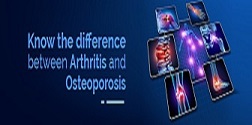Know your Pain: The Difference Between Arthritis and Osteoporosis
Oct 21, 2022

Arthritis and Osteoporosis are both long-term, chronic illnesses that impact your bones. Arthritis causes joint swelling, inflammation, and pain. Osteoporosis is caused by a reduction in bone mass and density and can result in fractures.
Osteoporosis can affect people of any age, including the elderly. Osteoporosis is a silent disease that goes unnoticed until a fracture occurs. Arthritis is most common in people in their forties and fifties. It is also more common in women and people having a family history of the condition. It can, however, develop at any age as a result of an injury or other joint-related disorders.
This blog sheds light on the differences between Arthritis and Osteoporosis, its symptoms and risk factors and also looks at available treatment.
What is Arthritis?
Arthritis is a joint ailment that affects more than 1.3 crore individuals (as per the 2021 news report) in India. People with Arthritis often complain of pain in their joints, which is localised and typically persistent. Arthritis pain is caused by inflammation around the joint, damaged joints from daily wear and tear or disease and muscle strains, which can worsen with age.
Early signs of Arthritis
That are several signs that you may brush off as minor discomfort, but they might hint at something more crucial. Here are the common symptoms that could indicate Arthritis:
- Joint pain
- Joint swelling and tenderness
- Joint stiffness
- Grating sound or sensation
- Pain
 in a previously injured joint
in a previously injured joint
What is Osteoporosis?
Osteoporosis is a medical disorder in which a person's bones have a low mineral density, leading them to become weak and brittle (prone to fracture, shattering, and other damage). Their bones become so fragile that they can break even while coughing or bending.
Some people are predisposed to Osteoporosis or osteoporotic fractures. Women are also more prone to Osteoporosis, especially after menopause. The chances of having osteoporosis increase with age.
Symptoms of Osteoporosis
Osteoporosis does not get identified easily, but the most common symptom is bone pain. Symptoms of Osteoporosis include:
- Back pain (caused by a fractured vertebra).
- Loss of height (over time).
- Stooped posture.
- Weak/fragile bones are prone to fracture.
Diagnosis
To get to the root of your joint discomfort, your healthcare practitioner will conduct a physical examination to assess the swelling of joints and other symptoms. If needed, you may consult a Rheumatologist to assert your condition and seek a diagnosis for Arthritis or Osteoporosis.
Arthritis
Your doctor will conduct the following tests to ascertain if you have Arthritis:
- Blood tests to rule out inflammatory Arthritis
- Blood screening test for rheumatoid factor (RF)
- X-rays or MRIs to look for joint damage
Osteoporosis
Your doctor will conduct a dual-energy X-ray absorptiometry or DEXA as they emit lower radiation than traditional ones and can be used repeatedly. A DEXA scan is recommended for adults over 50 years, who may have had a recent fracture from a minor accident, but also for women over 65, women with risk factors for Osteoporosis, men over 70 and men under 70 who smoke, who have height loss or other osteoporosis risk factors.
Risk Factor
Age, being overweight or obese, having repetitive injuries, and personal history of psoriasis can put you at risk of having Arthritis. While old age, gender, body size, taking certain medications, having a nutrient deficiency, smoking or drinking alcohol may put you at high risk of Osteoporosis.
You should listen to the signs your body gives so that you can take timely action and necessary measures to alleviate the pain and live with the condition.
Related Blog Post
Blog Categories
- Child Health
- Mens Health
- Women's Health
- Mental Health
- Health Myths & Facts
- Fitness
- Nutrition/Recipes
- Remedies
- Weight Management
- Stress Management
- Health Supplements
- Addiction Management
- Disease Management
- Allergy
- Anemia
- Arthritis
- Asthma
- Autoimmune Diseases
- Blood Pressure
- Cancer
- Deficiencies
- Dengue/Malaria/Chikungunya
- Diabetes
- Eye Problems
- Heart Diseases
- Hepatitis
- HIV/AIDS/STD
- Hormonal Imbalance
- Infection/Flu/Viral
- Kidney
- Liver
- Menstrual Problems
- Pregnancy
- Skin & Hair Problems
- Stomach Ailments
- Thyroid
- Others
- Health Checkups
- Diagnostics/Pathology
- Lifestyle & Wellness
- Covid
- Medical Tests
- Cholesterol
- Health Tips
- Parent Care/Old Age
- Lungs
- Food Intolerance








